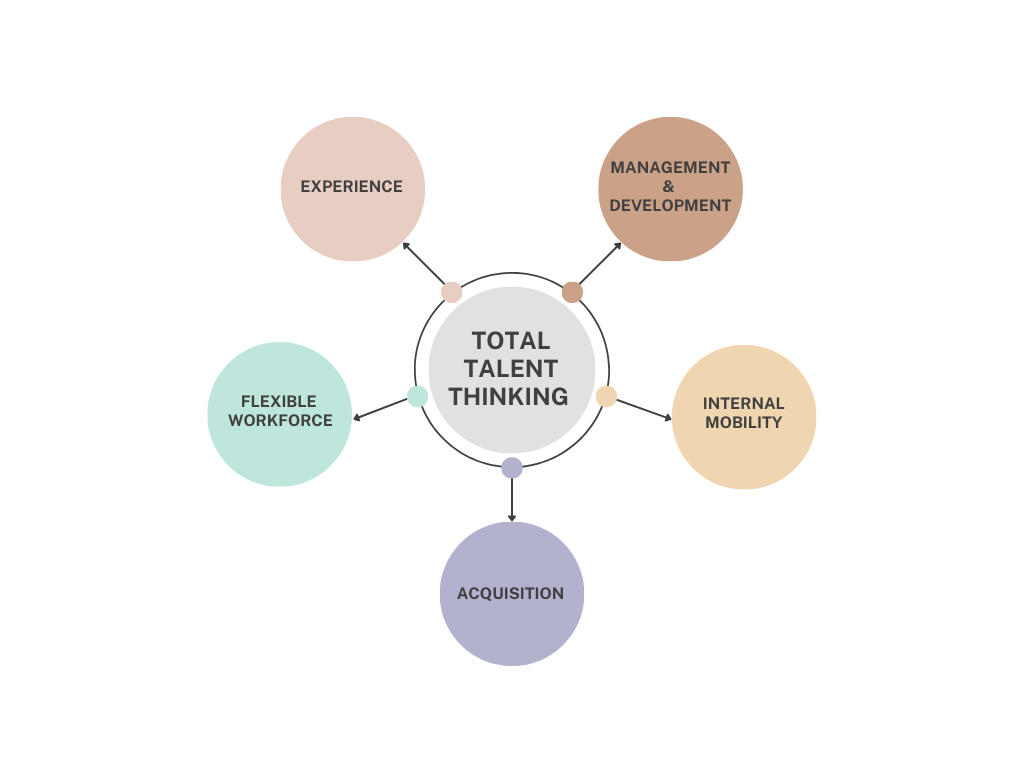Total Talent Thinking: A skills-based hiring model to avoid future talent shortages
- 5 Min Read
As AI, demographic shifts, and economic conditions necessitate a shift to skills-based hiring, Matt Alder presents the Total Talent Thinking model as a long-term approach to avoiding future talent shortages and gaining a competitive advantage.
- Author: Matt Alder
- Date published: Sep 26, 2023
- Categories

Predicting the course of talent acquisition in our current landscape is a complex task. Nevertheless, three primary drivers – AI, demographic shifts, and economic conditions – are compelling employers to reassess their talent strategies AI’s rapid development is a paradigm shift for recruitment, offering automation, personalization, and real-time data-based optimization, while simultaneously disrupting traditional job structures. Demographic changes, including an aging population and changing workforce expectations, demand a flexible approach to talent acquisition. Economic circumstances, further aggravated by the pandemic, have intensified competition for top talent, a challenge likely to persist for years to come. In this context, adopting Total Talent Thinking becomes crucial.
The changing landscape has highlighted the importance of skills-based hiring, focusing on specific capabilities rather than traditional qualifications. While this approach allows employers to tap into a broader talent pool, it presents its challenges, primarily understanding existing skills and future skill requirements.
Total Talent Thinking emphasizes a combined approach to internal mobility, talent management, and talent acquisition, extending to contingent, fractional, and project-based workforces, all treated with equity.
As we prepare for the future, employers must adopt a long-term, holistic, and strategic approach to workforce planning, such as Total Talent Thinking, that breaks down silos and ensures that employees acquire and retain the right skills irrespective of employment type.
Embracing Total Talent Thinking

In our book Digital Talent (Kogan Page 2022), Mervyn Dinnen and I set out the concept of Total Talent Thinking. The only way organizations will be able to deal with the shifting talent landscape is through a combination of internal mobility, talent management, learning and development, talent acquisition, and access to contingent, fractional, and project-based workforces.
At its core, Total Talent Thinking merges the strengths of internal mobility, learning & development (L&D), talent acquisition, and the strategic utilization of contingent and on-demand workforces. As HR leaders look to the future, harnessing AI can bridge the gap between internal and external talent, ensuring the right skills are available at critical moments.
With the rise of the gig economy and non-traditional approaches to employment, HR leaders must ensure their organizations focus on parity across these different types of workers. This includes providing fair compensation, opportunities for development, and a supportive work environment that fosters engagement and productivity.
To truly embed Total Talent Thinking, HR leaders must champion a culture where every worker, whether permanent or temporary, is valued equitably. By doing so, companies not only enhance their reputation but also position themselves to get a genuine talent advantage in marketplaces that will only get more competitive in the future.
While that may sound obvious in some ways, the key aspect of Total Talent Thinking is parity across these different types of workers. This includes providing fair compensation, opportunities for development, and a supportive work environment that fosters engagement and productivity. Those employers that focus on equity of treatment and experience for all workers regardless of their employment status will be the ones who get the genuine talent advantage.
Skills-Based Hiring: The New Norm?
The evolving landscape has highlighted the importance of skills-based hiring. As roles become more complex and interdisciplinary, hiring based on specific skill sets, rather than traditional qualifications or job titles, is becoming an increasingly logical approach.
By focusing on the capabilities required to perform tasks effectively, employers can tap into a broader talent pool, including career switchers, fractional resources, and underrepresented groups often overlooked by traditional hiring methods. This approach can also support internal mobility and career progression, allowing existing employees to transition into new roles that match their evolving skill sets.
There are though significant challenges here with many employers struggling to understand the skills they will need and the skills they already have in their organization. This is a massive intellectual and logistical shift for talent professionals but one that is very necessary for companies to compete effectively in the talent markets of the future.
Although the technology is still at an early stage both in terms of sophistication and adoption, AI will play a significant role in the future of skills-based hiring. As dynamic talent marketplaces evolve organizations will be able to gain real-time insights into the availability and skills of potential candidates, both within and beyond their existing workforce. This agility will enable companies to navigate talent shortages, adapt to fluctuating demand, and maintain a critical competitive edge.
Preparing for the future with Total Talent Thinking
The shift required to prepare for the future is a large and daunting one which demands immediate action. Although, in such disruptive times it can be tempting to focus on tactical actions just to get through the next month or quarter, taking a long-term strategic view is crucial.
As a starting point, employers need to take a progressive and holistic approach to strategic workforce planning. However, this will only be effective if there is transparency rather than silos between talent acquisition, talent management, and L&D.
The talent acquisition function of the AI-driven future will focus on getting and keeping the right skills in the business and its full-time employees, fractional hires, freelancers, or highly specialized automated technologies.
____________
Matt Alder is a strategic consultant focusing on innovation and technology in HR and Talent Acquisition. He is the host of Recruiting Future, one of the world’s most popular talent acquisition podcasts, and, over the last 20 years, has built a reputation as a global thought leader, working with employers to optimize their digital strategies. He is the co-author of two books “Exceptional Talent” (Kogan Page, 2017) and “Digital Talent “(Kogan Page, 2022), and has delivered keynote speeches at industry events in 17 countries.








